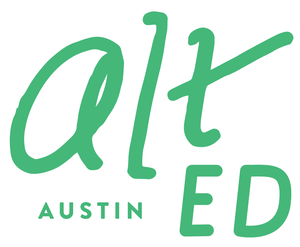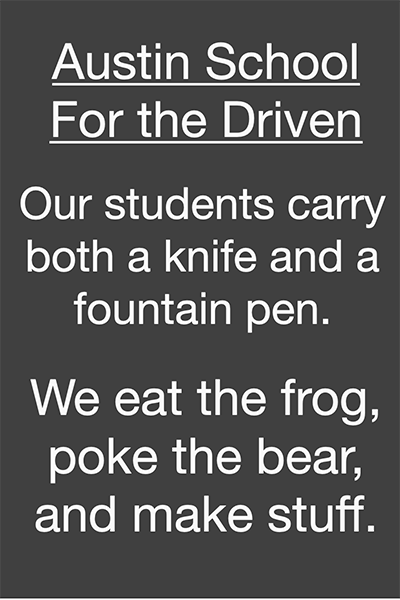Getting a summer education
/Annette Lucksinger is an instructor at St. Edward’s University, a mom of two, and author of the guidebook and mobile app Exploring Austin with Kids. She stopped by Alt Ed Austin to share some of her best ideas for fun places around Austin to learn with kids this summer. You can find even more ideas for summer adventures in Annette’s guide, or read about her favorite places, events, and people on the Exploring Austin with Kids blog.
Summertime learning is my favorite kind. It’s looser, less structured. There are no alarm clocks. No tardy bells. We can stay at an activity for as long as our focus will hold, and lessons tend to be more hands-on and experiential. Learning comes as fun.
It’s a sensory season too. Blasts of heat greet us as we walk outdoors, balanced by snow cones, ice cream, and sweet plunges into springs and swimming pools. Squeals of joy, splashes, and the whistles of lifeguards fill the air, hushed by the quiet glow of lightning bugs as things wind down after long, full days.
As we jump into summer, here are some ideas for keeping kids’ minds and bodies active while making for a memorable, fun-filled summer. Even better, most of them are free!
Summer Events
View the Congress Avenue Bridge Bats by Boat
While the bats are impressive to watch by land (and free with an informational kiosk nearby), viewing them by boat makes it even more educational. Captain-led tours offer information about bats, as well as history, city planning, and the changing Austin skyline as you tour the lake waiting for sunset. Pack snacks and drinks.
When: Departures 30 minutes before sunset; tours last an hour.
Where: Book through Lone Star River Boat or Capital Cruises.
Tips: Make reservations, and allow time for parking.
Nature Nights at Lady Bird Johnson Wildflower Center
This annual event teaches young visitors about Texas ecology and its plants and animals through nature crafts, short expert-led hikes, and interactive presentations and activities. Each week focuses on a unique theme, and the new Luci and Ian Children’s Garden makes it a perfect place to spend an evening. Check the website for this year’s schedule.
When: Thursday evenings in June and July from 6pm to 9pm.
Tips: Get there early for parking (and for a limited number of auditorium tickets when a presentation is part of the week’s event). Pack bug repellent.
Zilker Hillside Theater
Younger children can absorb the arts as they roll and roam on the hillside while older kids take it in from blankets beneath the stars. Pack a picnic and drinks. (If you arrive early, set up your blanket, then take a dip in Barton Springs Pool or hop on the Zilker Zephyr while you await the evening festivities.) It’s a nice way to introduce children to Shakespeare (Thursdays–Sundays in May). In July and August, performances shift to Broadway musicals. Free.
When: Performances begin at sundown. Stake your spot beginning at 6pm.
Tips: Pack snacks, drinks, pillows, and glow sticks.
Museums
Art, history, science, and natural history lessons for all ages can be experienced at nearby museums. Another good thing about these is that many of them are air-conditioned for those hot summer days, and all of them offer free days or times. (Museums are listed below in order of age appeal.)
Thinkery
When visiting Austin’s children’s museum in the Mueller development, add a picnic in Lake Park across the street or a swim in the neighborhood’s Ella Wooten Pool or nearby Bartholomew City Pool. For babies and toddlers, visit the museum during Baby Bloomers hours when the museum is open exclusively for ages 0–3 (Mondays 9am –12pm and Saturdays 9am– 10am). Every Wednesday from 4pm– 8pm admission is free or by donation.
Umlauf Scuplture Garden
This outdoor museum offers lush, shady places to wander along stroller-friendly paths past beautiful sculpture pieces. Ask for the scavenger hunt for preschoolers and up. Free on Family Day, Sunday, June 7th, with special activities for 4- to 10-year-olds.
Contemporary Museum at Laguna Gloria
Strolling the paths of this beautiful spot along Lake Austin, kids can seek out the new art installments added to the grounds or visit the Driscoll Villa to see European-style architecture. You can also check out an Action Pack filled with materials to engage kids during their visit. Second Saturdays Are for Families offers hands-on activities for kids age 2–11. Free every Tuesday.
Bob Bullock Texas History Museum
With plenty of room to roam among three floors of Texas history exhibits and with its two theaters showing feature films and short educational films on animals, the Lone Star state, and history, this museum is a favorite, especially on hot or rainy days. Family storytimes are on Mondays at 11am during the summer. First Sundays offer free admission and additional kid-focused activities.
Texas Memorial Museum
In this museum on the University of Texas campus, you will find three floors of animal, insect, fossil, and bone exhibits from dinosaur times to modern day, with a fourth floor to engage older children in evolution and biodiversity. Free on Saturday, June 6, with family activities 10am–4pm.
Camp Mabry Military Museum
For children interested in Texas military history from 1903 to present day, this spacious museum in Camp Mabry’s old mess hall houses a surprisingly engaging collection for kids that is worth checking out. Tanks, helicopters, and aircraft are on display outside the museum, and a nature trail and pond are also on the base. Take your driver’s license for entry. Free, or by donation.
Texas Capitol Visitors Center
Ever wondered what the white building at the edge of the Capitol grounds holds? It’s not just for tourists! This free museum offers hands-on, kid-focused Texas history exhibits, and the building itself is fun to explore, with hidden staircases and telescopes.
Blanton Museum of Art
My favorite exhibit for young children is Cildo Meireles’ How to Build Cathedrals in the Modern Art Gallery, while older children will find a variety of their own favorites. Free on Thursdays.
Farm Life
Boggy Creek Farm
This urban farm allows kids to see how the food they eat is grown, and with the market open Wednesday–Saturday mornings, they can taste it too. The farm also offers a glimpse into Austin’s past with its old farmhouse on the grounds. Young kids will enjoy the chickens and adjacent dirt pile for playing in.
Crowe’s Nest Farm
For a short day trip, this educational farm near Manor offers tours of themed gardens, a milking barn, and a host of animals, from those you would expect to see on a farm (dairy cows, goats, pigs, and chickens) to more exotic creatures that make their home here (bison, emus, coatimundis, and raptors). Picnic tables are available for lunch/snacks. Contact the farm for reservations. They also host a half-day summer camp in June.
Green Gate Farms
Education is central to the mission of this East Austin farm. While families are welcome to visit during market hours, kids can get a true sense of agricultural life during “Farmer for a Day” camp or in weeklong, themed “Summer Farm Camps.” Learning the skills that used to be absorbed through daily life on the farm, campers become empowered to plant, harvest, cook (in a solar oven), and preserve food. Or they might choose to tend to the livestock, build farm structures, focus on the microscopic (including fairies), or learn of farming systems from around the world. (Another bonus: workshops and “Farm Camp for Adults” are offered too.)
Annette Lucksinger


















